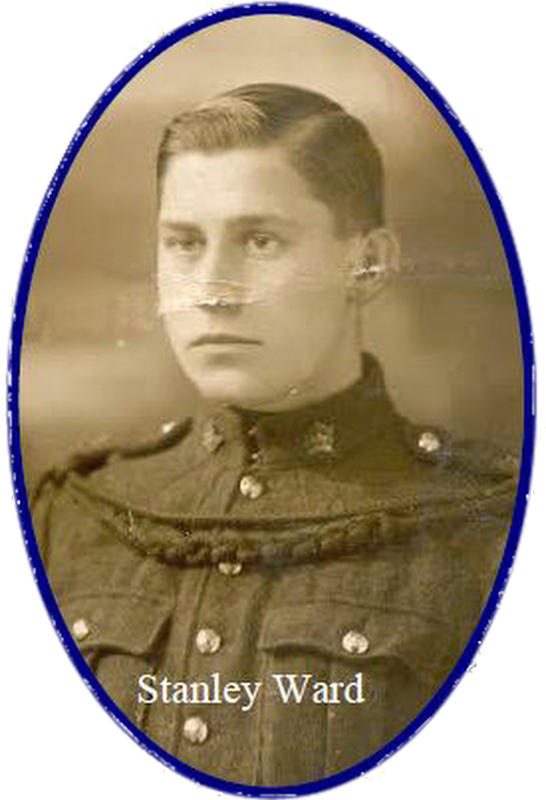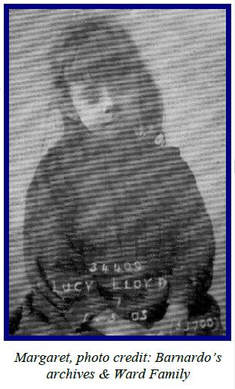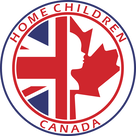CELEBRATING THE CONTRIBUTIONS OF BHC TO OUR SOCIETY
Special release: September 28th 2018
Canada's First National British Home Children's Day
THE SEYMOUR AND THE WARD FAMILY
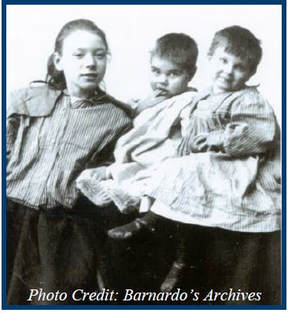
Florence Seymour was born on the
4th of December, 1891 in Liverpool, England. She was the eldest of three sisters, Rose, born in 1899 and Catherine, born in 1901.
Florence and Rose are found living in
West Derby in the 1901 census, their
mother Emily listed as a widow. Catherine was born very shortly after
the 1901 census was taken. Emily’s
husband was thought to have been an officer in the British Army, but very little is known about him. It is
assumed that he died sometime before Catherine’s birth in 1901. Emily, like many other single mothers, found herself in a difficult position of trying to support and raise children on her own. The children were relinquished to the care of the Dr. Barnardo Homes. The exact circumstances and the date remains unknown, but it is thought to have been shortly after Catherine's birth.
Florence was sent to Canada on the 19th of April, 1904 aboard the SS Kensington. Upon arrival she was taken to the Hazelbrae Home in Peterborough, then put out to work. According to the family story, Florence was placed with twospinster teachers. When she finished grade school, the teachers decided she’d had enough education and pulled her out of school to put her to work full time on the farm. Rose and Catherine arrived in Canada together, also throughthe Dr. Barnardo Homes, on the 28th of May, 1909. In about 1914, Florence was “adopted” by a physician’s family from the USA. When vacationing in Canada, the family met Florence and decided to bring her back to New York as their nanny. The family was good to her and allowed Florence to finish her schooling. She trained as a nurse in the New York Hospitals.
Florence also worked for other families, one taking her to the Jersey Shore to care for their children while on vacation. While working there, she met George Robert Pettit who worked in the area delivering ice for his father’s business. Love flourished and couple were married in Manhattan, New York on the 14th of April, 1928. Shortly after, they relocated to West Long Branch. George Robert Pettit, known as Robert, their first born son, arrived on the 8th of June, 1929. Life was not easy for this new couple and their new born son. With the crash of the stock market, George, then working with the New York Central Railroad, lost his job. With Florence, having given up her
work while pregnant, they found themselves “thrown to the wolves.”
There were no social systems in place to help families in need. The family managed to survive a few years by
George working odd jobs and Florence taking in laundry at 25¢ an hour. Some relief came when in about 1933, West Long Branch, initiated a welfare program. Still the family struggled, on the brink of starvation at times, surviving on an endless supply of potatoes, eating them for breakfast, lunch and dinner!
Two more children were born during this time, Stanley in 1932 and Kenneth in 1936. With a hungry and growing
family of five, her husband working odd jobs, Florence was forced to look for more work. Things took another turn for the worse in 1937, when Stanley, only five years old, became seriously ill. By the time the destitute family were able to get medical help, it was too late. Stanley died of a burst appendix.
Florence herself became seriously ill with scarlet fever. Anxious that she would die, her son Robert stayed by her
side. With sheer tenacity and a strong will to survive, Florence rallied and continued to fight for her family. She
stood up to foreclosure efforts made on their home and thwarted attempts repossess their family car. However, they lost the battle to keep their home. Things improved when George was hired back by the New York Central Railway and Florence found work making clothing for the troops during the Second World War. The family was never very well off, but Florence and George loved their sons and cared for them the very best they could.
Robert suffered from bullying while in school. At its worst, his nose was broken by other kids beating him up. It was clear to him that there were certainly some bad people in this world. It also was clear to him, that he had to be tenacious and tough to survive.
When Robert was young, his neighbor, Albert, invited him over one night to play with a new chemistry set he’d received. A new passion was born in Robert. At ten years of age he earned enough money by mowing lawns to purchase his own chemistry set. Robert never looked back, becoming one of the worlds top organic chemists. He specializes in anti cancer treatments and holds sixty-five anti-cancer patents at the Arizona State University. Robert founded the Cancer Research Institute on the campus and pioneered the development of anticancer drugs from marine compounds. As a child, Robert has wondered often why fish did not get cancer.
4th of December, 1891 in Liverpool, England. She was the eldest of three sisters, Rose, born in 1899 and Catherine, born in 1901.
Florence and Rose are found living in
West Derby in the 1901 census, their
mother Emily listed as a widow. Catherine was born very shortly after
the 1901 census was taken. Emily’s
husband was thought to have been an officer in the British Army, but very little is known about him. It is
assumed that he died sometime before Catherine’s birth in 1901. Emily, like many other single mothers, found herself in a difficult position of trying to support and raise children on her own. The children were relinquished to the care of the Dr. Barnardo Homes. The exact circumstances and the date remains unknown, but it is thought to have been shortly after Catherine's birth.
Florence was sent to Canada on the 19th of April, 1904 aboard the SS Kensington. Upon arrival she was taken to the Hazelbrae Home in Peterborough, then put out to work. According to the family story, Florence was placed with twospinster teachers. When she finished grade school, the teachers decided she’d had enough education and pulled her out of school to put her to work full time on the farm. Rose and Catherine arrived in Canada together, also throughthe Dr. Barnardo Homes, on the 28th of May, 1909. In about 1914, Florence was “adopted” by a physician’s family from the USA. When vacationing in Canada, the family met Florence and decided to bring her back to New York as their nanny. The family was good to her and allowed Florence to finish her schooling. She trained as a nurse in the New York Hospitals.
Florence also worked for other families, one taking her to the Jersey Shore to care for their children while on vacation. While working there, she met George Robert Pettit who worked in the area delivering ice for his father’s business. Love flourished and couple were married in Manhattan, New York on the 14th of April, 1928. Shortly after, they relocated to West Long Branch. George Robert Pettit, known as Robert, their first born son, arrived on the 8th of June, 1929. Life was not easy for this new couple and their new born son. With the crash of the stock market, George, then working with the New York Central Railroad, lost his job. With Florence, having given up her
work while pregnant, they found themselves “thrown to the wolves.”
There were no social systems in place to help families in need. The family managed to survive a few years by
George working odd jobs and Florence taking in laundry at 25¢ an hour. Some relief came when in about 1933, West Long Branch, initiated a welfare program. Still the family struggled, on the brink of starvation at times, surviving on an endless supply of potatoes, eating them for breakfast, lunch and dinner!
Two more children were born during this time, Stanley in 1932 and Kenneth in 1936. With a hungry and growing
family of five, her husband working odd jobs, Florence was forced to look for more work. Things took another turn for the worse in 1937, when Stanley, only five years old, became seriously ill. By the time the destitute family were able to get medical help, it was too late. Stanley died of a burst appendix.
Florence herself became seriously ill with scarlet fever. Anxious that she would die, her son Robert stayed by her
side. With sheer tenacity and a strong will to survive, Florence rallied and continued to fight for her family. She
stood up to foreclosure efforts made on their home and thwarted attempts repossess their family car. However, they lost the battle to keep their home. Things improved when George was hired back by the New York Central Railway and Florence found work making clothing for the troops during the Second World War. The family was never very well off, but Florence and George loved their sons and cared for them the very best they could.
Robert suffered from bullying while in school. At its worst, his nose was broken by other kids beating him up. It was clear to him that there were certainly some bad people in this world. It also was clear to him, that he had to be tenacious and tough to survive.
When Robert was young, his neighbor, Albert, invited him over one night to play with a new chemistry set he’d received. A new passion was born in Robert. At ten years of age he earned enough money by mowing lawns to purchase his own chemistry set. Robert never looked back, becoming one of the worlds top organic chemists. He specializes in anti cancer treatments and holds sixty-five anti-cancer patents at the Arizona State University. Robert founded the Cancer Research Institute on the campus and pioneered the development of anticancer drugs from marine compounds. As a child, Robert has wondered often why fish did not get cancer.
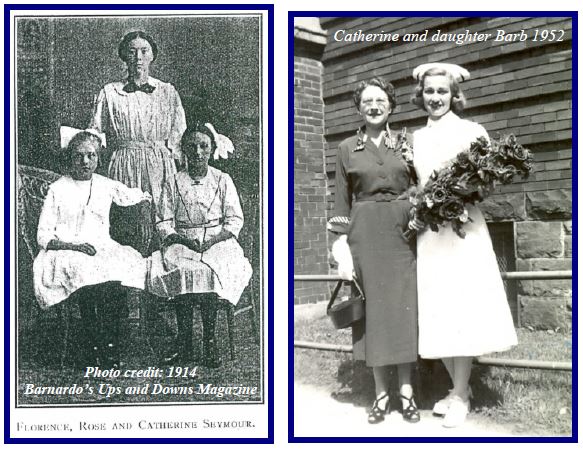
Over the years, Florence’s sisters were able to keep in touch with her, often visiting her in the United States. In 1983, Robert was speaking at an international symposium in Paris, when he received a telegram telling him that his mother had died of a stroke, in her sleep.
Rose struggled through many adversities in her life as well, losing her only daughter, Marion Florence, at six months of age and her husband, Frederick Gay, who died at the age of 52 in 1946. Frederick was born in England. He immigrated to Canada in 1914, at the age of nineteen, as a farm worker, much like the BHC. Frederick was an orphan, with three surviving siblings in the UK, but no family in Canada.
Rose and Fred, who married 2 Jun 1921, raised their two surviving children, Stanley and his younger brother Ralph. Stan served with the RCAF in the Second World War, attached to the RAF/Bomber Command, 106 Sqd. Stan was shot down July 7,1944 and survived a fall with only one arm in a burning parachute and was MIA behind enemy lines till meeting up with Canadian/American D-Day soldiers at end of Aug 1944. Rose's husband was in the Veteran's Guard and also on duty away from home. Rose was left at home, with young Ralph, to cope.
With her tremendous, stamina, possibly a carryover from her childhood, she survived this and the loss of her husband. Rose lived a comfortable life until her death from cancer in June of 1958.
Catherine Seymour, the third sister, moved to Toronto and worked at Eatons Dept Store. She her daughter Barabara Marilyn Claridge in Toronto. Catherine was very religious and very devoted to the church. She was very involved in the Church's activities and wrote the Church’s newsletter. Catherine lived to be 92, born in 1901 and passing away in 1993. Barbara graduated as the top Registered Nurse from Toronto General's Nursing class of 1952 and was featured in the Toronto Star and Telegram. She went on to work over 40 years as a Nurse.
Barbara married Frank Lloyd Ward, who like Barbara was a first generation BHC descendant. Frank was born in 1925 to son of Stanley Edward Ward and his wife Margaret Lucy Lloyd. Both Stanley and Margaret were BHC.
Frank enlisted in 1943 to RCAF to join his brother Walter, but flying on a Lancaster like Stan Gay. but with the 48th
Highlander 514 Squadron. After the war Frank attended the University of Toronto to become a Industrial Engineer. He was hired at Avro, where he worked on the plans and production of Canada’s iconic twinengine, high-speed fighter-interceptor jet. This jet was being built to be the fastest aircraft. Believing that American missiles were going to make manned fighter jets obsolete, Diefenbaker ordered the Arrow production stopped and all 37 Avro
Arrows were destroyed, one of the Prime Minister’s biggest mistakes.
Following this Frank secured a salary job, with great benefits, with the Ford Motor plant in Oakville. He worked there until his death from a heart attack in May of 1976. Frank was only 50 when he died. Barbara continued to care for their two children, Frank and Janice. Barbara died in 2003 at the age of 72 and is buried in the York Cemetery in Toronto, with her husband Frank and mother Catherine.
Stanley Edward Ward & Margaret Lucy Lloyd
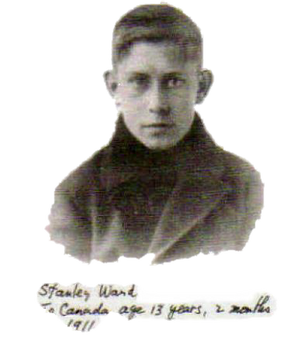
Intertwined with the Seymour family we found the the Ward family and more notable British Home Children. Catherine Seymour’s daughter, Barbara Marilyn Claridge married Frank Lloyd Ward, son of Stanley Edward Ward and his wife Margaret Lucy Lloyd. Both Stanley and Margaret were British Home Children, both brought to Canada with the Dr. Barnardo Homes.
Stanley, born July 22, 1898 in West Norwood,
London, England; was one of eight children born to Harry William Ward and his wife Bridget Louisa Baker. Harry and Bridget kept a small shop and unfortunately their married life was an
unhappy one, eventually breaking down. As a result, Stanley was admitted to Dr. Barnardo’s on 15 January 1908. In April he was transferred to the Chelsea Villas in Felixstowe, Sussex; a seaside convalescent home and holiday home for the Barnardo children. The reason for Stanley’s admission is not known.
In September of 1911, with permission from both his parents, Stanley was sent to Canada aboard the SS Corinthian. He was placed with Kenneth McLennan in Slade, Ontario. Representatives of the Dr. Barnardo Homes visited him yearly and their reports describe him as “steady, willing, industrious, truthful, mannerly and gentlemanly in behavior.
9 Jan 1915 he was moved to Lorne, Ontario to work with William Bland. Reports indicated he had a lump the size of an egg removed from his right elbow. Tuberculosis was feared but his arm healed.
On 25 Jan 1915, in Walkerton, Ontario, sixteen year old Stanley enlisted in the Canadian Over-Seas Expeditionary Force. He, like many BHC, falsified his age, so he could enlist. His scar on his right elbow was noted and his regimental number was 602243. On 10 August 1916 he proceeded to France. Stanley suffered a severe gun-shot wound to the face. The wall of his lower jaw was smashed and five teeth were missing. After recovering in hospital, Stanley returned to the trenches. In May of 1917 Stanley volunteered to give sufficient blood to another patient in the No 1 Canadian Hospital, Etaples, although injured himself.
He was discharged from the Army in July of 1919 with the British War Medal and the Victory Medal. Upon his return to Canada he was admitted to hospital with a tuberculous arm. While in hospital he met a volunteer, Margaret Lucy Lloyd. Margaret was born 28 June 1897 in Cardiff, Wales to single mom Dorothy Lloyd. Margaret's birth name was Lucy Margaret Howell. Her mother was working as a dress maker for the famed Howell’s Department Stores when she was seduced by J. C. Howell, nephew of the owner James Howell. Howell
refused to take responsibility for the child, leaving Dorothy and her mother, Elizabeth Walters, to raise the child without his support. Dorothy contracted tuberculosis and after a lengthily illness, died in 1903 in the Cardiff Union Hospital. Elizabeth, now a widow, tried to care for Margaret on her own, but a troubled life made that impossible.
On 29 April 1905, Margaret was relinquished to the care of the Dr. Barnardo Homes. Initially placed in the Barkingside Girls Village Home, she was later sent to a home in Weymouth, Dorset then boarded out in Stansted, Kent. She was returned to Barkingside shortly before sailing to Canada 8 Oct 1908. Margaret was taken to the Hazelbrae Receiving Home in Peterborough before being sent out on her first placement with Mrs. Robert Southworth in Cavanville, Ontario. By all written accounts, Margaret faired well in her placement. She was described as a happy child, trustworthy and treated as one of the family. Later in her inspection reports, this comment was made: “obedient tho rather difficult to manage”. The Southworth’s expressed their desire to keep Margaret with them for the next couple of years as she was very happy and very fond of them.
The Southworth family moved to Toronto in September of 1909, taking Margaret with them. Just days before Christmas that year, she was returned to Hazelbrae for being “wilful and naughty”. Margaret was moved through several homes before taking a job with Robert Simpson Co, a Canadian department store chain. Margaret also worked as a Bell telephone operator and in 1919, she was a hospital volunteer. While working at the
Christie St Hospital in Toronto hospital in Toronto, she met her future husband Stanley Ward.
Stanley, born July 22, 1898 in West Norwood,
London, England; was one of eight children born to Harry William Ward and his wife Bridget Louisa Baker. Harry and Bridget kept a small shop and unfortunately their married life was an
unhappy one, eventually breaking down. As a result, Stanley was admitted to Dr. Barnardo’s on 15 January 1908. In April he was transferred to the Chelsea Villas in Felixstowe, Sussex; a seaside convalescent home and holiday home for the Barnardo children. The reason for Stanley’s admission is not known.
In September of 1911, with permission from both his parents, Stanley was sent to Canada aboard the SS Corinthian. He was placed with Kenneth McLennan in Slade, Ontario. Representatives of the Dr. Barnardo Homes visited him yearly and their reports describe him as “steady, willing, industrious, truthful, mannerly and gentlemanly in behavior.
9 Jan 1915 he was moved to Lorne, Ontario to work with William Bland. Reports indicated he had a lump the size of an egg removed from his right elbow. Tuberculosis was feared but his arm healed.
On 25 Jan 1915, in Walkerton, Ontario, sixteen year old Stanley enlisted in the Canadian Over-Seas Expeditionary Force. He, like many BHC, falsified his age, so he could enlist. His scar on his right elbow was noted and his regimental number was 602243. On 10 August 1916 he proceeded to France. Stanley suffered a severe gun-shot wound to the face. The wall of his lower jaw was smashed and five teeth were missing. After recovering in hospital, Stanley returned to the trenches. In May of 1917 Stanley volunteered to give sufficient blood to another patient in the No 1 Canadian Hospital, Etaples, although injured himself.
He was discharged from the Army in July of 1919 with the British War Medal and the Victory Medal. Upon his return to Canada he was admitted to hospital with a tuberculous arm. While in hospital he met a volunteer, Margaret Lucy Lloyd. Margaret was born 28 June 1897 in Cardiff, Wales to single mom Dorothy Lloyd. Margaret's birth name was Lucy Margaret Howell. Her mother was working as a dress maker for the famed Howell’s Department Stores when she was seduced by J. C. Howell, nephew of the owner James Howell. Howell
refused to take responsibility for the child, leaving Dorothy and her mother, Elizabeth Walters, to raise the child without his support. Dorothy contracted tuberculosis and after a lengthily illness, died in 1903 in the Cardiff Union Hospital. Elizabeth, now a widow, tried to care for Margaret on her own, but a troubled life made that impossible.
On 29 April 1905, Margaret was relinquished to the care of the Dr. Barnardo Homes. Initially placed in the Barkingside Girls Village Home, she was later sent to a home in Weymouth, Dorset then boarded out in Stansted, Kent. She was returned to Barkingside shortly before sailing to Canada 8 Oct 1908. Margaret was taken to the Hazelbrae Receiving Home in Peterborough before being sent out on her first placement with Mrs. Robert Southworth in Cavanville, Ontario. By all written accounts, Margaret faired well in her placement. She was described as a happy child, trustworthy and treated as one of the family. Later in her inspection reports, this comment was made: “obedient tho rather difficult to manage”. The Southworth’s expressed their desire to keep Margaret with them for the next couple of years as she was very happy and very fond of them.
The Southworth family moved to Toronto in September of 1909, taking Margaret with them. Just days before Christmas that year, she was returned to Hazelbrae for being “wilful and naughty”. Margaret was moved through several homes before taking a job with Robert Simpson Co, a Canadian department store chain. Margaret also worked as a Bell telephone operator and in 1919, she was a hospital volunteer. While working at the
Christie St Hospital in Toronto hospital in Toronto, she met her future husband Stanley Ward.
Stanley and Margaret were married 12 May 1922 in York, Ontario. They had three children, Walter, Frank and Melville. In 1930, suffering from mental illness, Stanley was admitted to the Ontario Hospital in Whitby where he remained until his death, due to kidney failure, 17 December 1946. Stanley is buried in the veteran's section of the Groveside Cemetery in Brooklin, located just north of Whitby on highway 12. Stanley’s illness and subsequent death, left Margaret to raise their three children alone. During Stanley’s illness, she worked part time for Elmore’s Drug Store. After his death she was employed by the Unemployment Insurance Commission on Richmond Street in Toronto. On 28 January 1965, while traveling home from work, Margaret suffered a coronary thrombosis and died. She is buried in the York Cemetery, the same cemetery as her son Melvin, Frank, his wife Barbara and mother to Barbara, Catherine.
At no time before Stanley and Margaret’s deaths did they ever tell their children they were British Home Children. This was found out by their son Walter. After visiting friends in England, he was encouraged to look into his own family background and was astonished at what he found!
Like Stanley, most of the Home Boys in Canada enlisted in the First World War. In fact over 10,000 did; a number which represents almost 100% enlistment rate of the Home Boys. Estimates sit between 15,000 and 20,000 enlistments for the Second World War. The numbers of descendants who enlisted are countless. Walter Ward is one of those descendants who served for our country in the Second World War. He flew more than 100 missions over the European war theatre during his time as a pilot with the RCAF 440 Squadron, including on D-Day, June 6, 1944, the Invasion of Normandy. Walter is one of the few surviving RCAF Hawker Typhoon (Tiffie) pilots. He
has been honoured in both Ottawa and his home town of Mississauga. The History Channel featured Walter’s story
in the show “Whistle for a Tiffie”. Walter was awarded the Knight of the Legion of Honour medal, France's highest
honour for military and civil merits. This award was established in 1802 by Napoléon Bonaparte. Walter’s contributions to Canada did not stop with his military service; he also became a local hero in his post war career as principal of the Gordon Graydon Memorial Secondary School in Mississauga. Although he was offered a full time career in commercial flying, he chose to attend university, graduating with a degree in English. Walter taught
English at Gordon Graydon Memorial School for years before he became the headmaster. Walter is remembered by his students as “epitome of cool, a lovable leader with a stylish flair (he was often celebrated for his artful collection of bowties) and a daring, Douglas F a i r b a n k s - l i k e moustache. He also had the wonderful capacity to make each student feel special, the only subject of his attention”(source: ‘Ward’ing off the enemy’ by
Rick Drennan, Mississauga News)
What is clear in the story of the Seymour family and the Ward family, is that they typify the legacy of the BHC, not only in the enormous contributions they made in the building of our great nation and their service in our Wars, but also in the families they raised and the millions of descendants that today, contribute enormously to the the fabric of our nation. Descendants who have compounded the contributions of our BHC immeasurably. BHC struggled and faced tremendous odds against them in Canada. Many did not survive or thrive, and we should never forget that. But we should also remember that most BHC, in spite of their adversities, created families and lives for themselves, wherever they eventually settled.
These children were made to feel ashamed of themselves in Canada. When we look back upon our BHC, we do not look back with shame, but with a great sense of pride. Because of their hardships we are who we are today. Because of their fortitude, we have descendants such as Bob Pettit, Walter Ward, Frank Ward, Barbara Claridge and Stanley Gay.BHC and their descendants have become mayors, Members of Parliament, hockey heroes, TV stars, doctors, lawyers, reporters, war heroes and became regular hard working people; raising families and
just getting on with life.
Article put together by Lori Oschefski with notes, information
and help from the Ward Family. Personal interview
with Walter Ward 18 June 2017. Bob Pettit’s story from
the book “Waging War on Cancer”
by Robert Robert S. Byars - robertsbyars.com
At no time before Stanley and Margaret’s deaths did they ever tell their children they were British Home Children. This was found out by their son Walter. After visiting friends in England, he was encouraged to look into his own family background and was astonished at what he found!
Like Stanley, most of the Home Boys in Canada enlisted in the First World War. In fact over 10,000 did; a number which represents almost 100% enlistment rate of the Home Boys. Estimates sit between 15,000 and 20,000 enlistments for the Second World War. The numbers of descendants who enlisted are countless. Walter Ward is one of those descendants who served for our country in the Second World War. He flew more than 100 missions over the European war theatre during his time as a pilot with the RCAF 440 Squadron, including on D-Day, June 6, 1944, the Invasion of Normandy. Walter is one of the few surviving RCAF Hawker Typhoon (Tiffie) pilots. He
has been honoured in both Ottawa and his home town of Mississauga. The History Channel featured Walter’s story
in the show “Whistle for a Tiffie”. Walter was awarded the Knight of the Legion of Honour medal, France's highest
honour for military and civil merits. This award was established in 1802 by Napoléon Bonaparte. Walter’s contributions to Canada did not stop with his military service; he also became a local hero in his post war career as principal of the Gordon Graydon Memorial Secondary School in Mississauga. Although he was offered a full time career in commercial flying, he chose to attend university, graduating with a degree in English. Walter taught
English at Gordon Graydon Memorial School for years before he became the headmaster. Walter is remembered by his students as “epitome of cool, a lovable leader with a stylish flair (he was often celebrated for his artful collection of bowties) and a daring, Douglas F a i r b a n k s - l i k e moustache. He also had the wonderful capacity to make each student feel special, the only subject of his attention”(source: ‘Ward’ing off the enemy’ by
Rick Drennan, Mississauga News)
What is clear in the story of the Seymour family and the Ward family, is that they typify the legacy of the BHC, not only in the enormous contributions they made in the building of our great nation and their service in our Wars, but also in the families they raised and the millions of descendants that today, contribute enormously to the the fabric of our nation. Descendants who have compounded the contributions of our BHC immeasurably. BHC struggled and faced tremendous odds against them in Canada. Many did not survive or thrive, and we should never forget that. But we should also remember that most BHC, in spite of their adversities, created families and lives for themselves, wherever they eventually settled.
These children were made to feel ashamed of themselves in Canada. When we look back upon our BHC, we do not look back with shame, but with a great sense of pride. Because of their hardships we are who we are today. Because of their fortitude, we have descendants such as Bob Pettit, Walter Ward, Frank Ward, Barbara Claridge and Stanley Gay.BHC and their descendants have become mayors, Members of Parliament, hockey heroes, TV stars, doctors, lawyers, reporters, war heroes and became regular hard working people; raising families and
just getting on with life.
Article put together by Lori Oschefski with notes, information
and help from the Ward Family. Personal interview
with Walter Ward 18 June 2017. Bob Pettit’s story from
the book “Waging War on Cancer”
by Robert Robert S. Byars - robertsbyars.com
